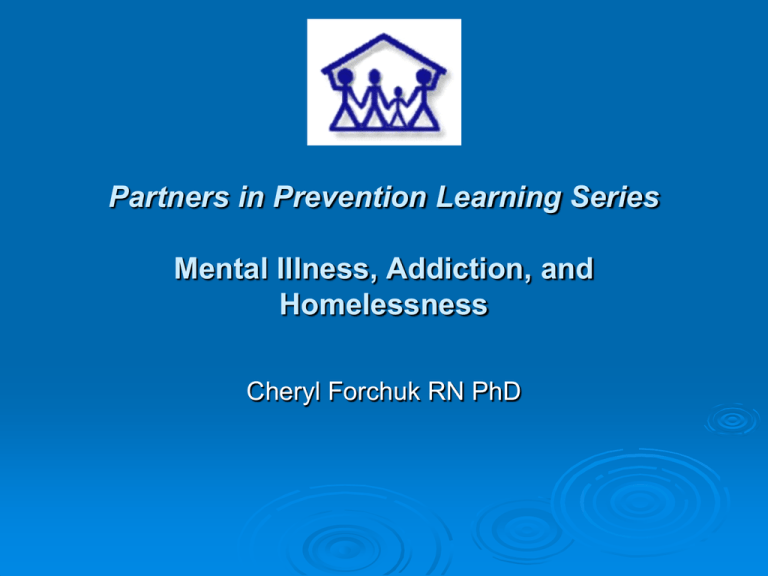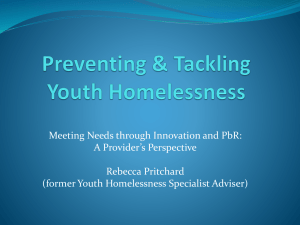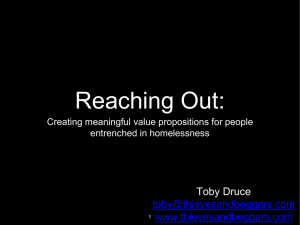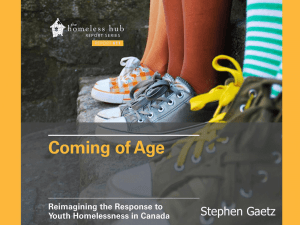PPT - The Homeless Hub
advertisement

Partners in Prevention Learning Series Mental Illness, Addiction, and Homelessness Cheryl Forchuk RN PhD Overview -relationship between homelessness and mental illness/addiction -preventing homelessness after psychiatric treatment -approaches for homeless youth with mental health and substance use problems relationship between homelessness and mental illness/addiction People with mental health and addiction challenges are consistently overrepresented in homeless populations? Why? Something about mental illness per se that predisposes to homelessness? Something about homelessness that predisposes to mental illness? Something about our societal response to mental illness and homelessness? Analogy of the musical chairs Chairs = available affordable housing People circling = poor Difference = homeless Housing Development Downloading; From federal (pre 1990’s) To provincial (until 1995) To municipal (e.g. Ontario) Canada is the only industrialized nation with no national housing policy Income Supports Most likely Welfare or disability Less likely WSIB CPP (Disability) Ontario Works (OW) – replaced general welfare assistance program Focus is on return to work ->temporary assistance Eligibility criteria to ‘encourage employment’…only used when all other resources exhausted 1998 Ontario Disability Support Program (ODSP) Social Reform Act of 1997 to provide both income and employment supports to persons with disabilities and to their dependants Strict criteria & difficult application process Mental Health Care: Deinstitutionalization? Evolving for decades Deinstitutionalization or de-hospitalization? In Ontario – 20 provincial planning documents in 20 years In 1960 there were 19,501 hospitalized patients in Ontario compared to 4,514 by 1982 (Heseltine, 1983, p. 19). beds that will be available post -restructuring [2003] estimated at 1,767 beds No increase to community mental health from 1993 for over a decade and small increases since Mirrored across the country & around the world Deinstitutionalization Or de-hospitalization? World wide trend What else did hospitalization provide: housing, food, social support Implications Huge disconnect between policies with psychiatric survivors caught in the gap Poorly understood since it crosses sectors Problem needs to be understood as systematic rather than personal preventing homelessness after psychiatric treatment Critical points related to intervention Discharge from psychiatric ward as a critical period where someone is at risk for homelessness Concerns from shelters about people coming directly from hospital Review of the Literature Academic papers vs. public press, shelter documents, websites Summary paper Forchuk, C., Russell, G., KingstonMacClure, S., Turner, K., Lewis, K., Dill, S. (2006) From Psychiatric Wards to the Streets and Shelters. Journal of Psychiatric and Mental Health Nursing 13(3), 301-308. http://www3.interscience.wiley.com/journ al/118598292/abstract?CRETRY=1&SR ETRY=0 Findings: Hospitals General Hosptial: 93 (53 male, 40 female) discharges No Fixed Address (including addresses for shelters). Psychiatric Hospital: 74 (no gender breakdown) Total : 167 in one year Findings: Shelters 105 males that arrived at the two separate male London shelters directly from a psychiatric ward 89 females arriving at the two separate women’s London shelters. Total: 194 in one year Why does this happen? System issues (shorter length of stay, accessing funds, affordable housing shortage….) Individual issues (housing history, income, ability to manage home…) Issues from hospital and shelter No easy fixes Trying to make the system work Finding housing First & last month’s rent Pilot Results: Forchuk, C., MacClure, S. K., Van Beers, M., Smith, C., Csiernik, R., Hoch, J., & Jensen, E. (2008). Developing and testing an intervention to prevent homelessness among individuals discharged from psychiatric wards to shelters and ‘no fixed address’. Journal of Psychiatric and Mental Health Nursing, 15, 569-575. http://ir.lib.uwo.ca/nursingpub/28/ 14 = 7 intervention, 7 control Significance? Looking just at shelter/homed Pearson chi2(1) = 10.5000 Pr = 0.001 Fisher's exact = 0.005 1-sided Fisher's exact = 0.002 Changing Usual Care 2007 – LHSC (phase 2) Fall 2008 – RMHC (phase 3) Available to all clients Program evaluation design Using computer linkages to housing data base & to Ontario Works directly from hospital 256 accessed service -0nly 3 discharged homeless Fall Shelter Data: Admissions directly from Psychiatric Wards 2009 Referrals to London Shelter from Acute care London Hospital (12 months) =11 Referrals to London Shelter from Tertiary care hospital = 4 Referrals to London Shelter from psychiatric wards outside of London = 4 Compared to 194 London total in 2002 Hospital Data Still 123 to NFA from acute care 9 to NFA from tertiary care Costs? the amount to maintain the program was approximately $3, 917 per month, which is less than the monthly cost of one family of four that becomes homeless ($5, 040). Other issues • Still had some discharges to homelessness from those not accessing the service • Difficulty in ongoing funding Implications System issues contribute the problem of discharge to NFA With multiple system changes, we can make things better approaches for homeless youth with mental health and substance use problems Youth matters in London Following 187 homeless youth Choice re service approach (housing first, treatment first, both approaches, other) Variety of responses – none a majority choice – but one goal preferred Goals shift quickly as progressed made Parenting issues: Number of children Number children 0 1 2 3 4 Declined to reply Frequency Percent 131 39 10 3 2 70.1 20.9 5.3 1.6 1.1 2 1.1 Head Injury “Have you ever had an injury to the head which knocked you out or left you dazed, confused or disoriented?” Frequency Percent No 83 44.4 Yes 103 55.1 1 .5 Don't know The average number of head injuries sustained over a lifetime was 13.2 (SD=47.8), Homeless Youth • Peer support can be developed as support • Lower level of income a challenge (rent gifts?) • Avoidance of many mainstream homeless resources Youth issues in service: quick tips Understand why homeless – why this is considered the best alternative (personal story, personal goals) Developmental stage Homelessness means living in the moment Peer relationships Family relationships Food and growth Sexuality Communicable illnesses & infestations income Conclusion Research related to homelessness is difficult and fraught with challenges However we can make a real difference through research Conclusion Importance of acknowledging the disconnect Importance of advocacy Web-page http://publish.uwo.ca/~cforchuk/cura/index. htm Contact Cheryl Forchuk, RN, PhD University of Western Ontario Lawson Health Research Institute - LHSC 375 South Street – NR201 London, ON N6A 4G6 Phone: (519) 685-8500, ext. 77034 Fax: (519) 432-7367









